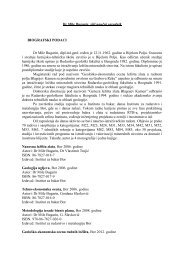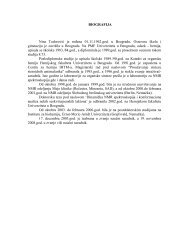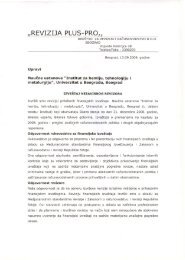Радно искуство - IHTM - Универзитет у Београду
Радно искуство - IHTM - Универзитет у Београду
Радно искуство - IHTM - Универзитет у Београду
You also want an ePaper? Increase the reach of your titles
YUMPU automatically turns print PDFs into web optimized ePapers that Google loves.
Modeling of motor fuel consumption and environmental pollution from the transportation sector in the Republic of Serbia<br />
Abstract<br />
This study is based on the application of mathematical methods of statistical analysis that can be<br />
used to predict the development of motor fuel consumption and pollutant emissions from motor<br />
vehicles in the Republic of Serbia. It should be noted that in these areas in the Republic of<br />
Serbia there was a significant lack of information. This fact has caused a methodological<br />
implementation, individually or in combination, of several different concepts: carrying out of<br />
analogies, making comparative analysis and statistical analysis of data from other countries.<br />
This study has taken into consideration the following fuels: gasoline fuel, diesel and liquefied<br />
petroleum gas (LPG), and among pollutants the following have been considered: carbon<br />
monoxide (CO), hydrocarbons (HC), particulate matter smaller than 10 μm (PM 10), nitrogen<br />
oxides (NOx) and carbon dioxide (CO2).<br />
Modeling of motor fuels consumption is based on the linear dependence of consumption growth<br />
of motor fuel based on the variation in gross domestic product per capita, which is then<br />
corrected by introducing five additional influencing parameters. To each of these parameters the<br />
corresponding coefficient has been assigned that measures the specific impact on the<br />
consumption of motor fuels. Model results indicate that the total consumption of motor fuels in<br />
Serbia from 2001 to 2025 will be increased by 79.5 %, or by 2.2 % per year, from 1.79 Mt to<br />
3.22 Mt. Diesel fuel consumption is expected to continue intensive growth, even though slightly<br />
slower than the achievements in the last decade. In 2025, consumption will reach a level of 2.08<br />
Mt, starting from 0.97 Mt in 2001. The average annual growth of diesel fuel consumption will<br />
amount to 3.1 %. The current trend of declining demand for gasoline will be stopped 2015-2016,<br />
followed by the slow growth in demand and consumption by 2025, stabilizing at around 700 Kt.<br />
The overall decline in gasoline fuel consumption over the whole period will be 9 %, or an<br />
average of 0.3 % per year. Consumption of LPG after a very rapid growth will enter the phase of<br />
saturation at around the year 2015. Average annual growth of LPG consumption will amount to<br />
8.5 %, from 61 Kt in 2001 to 448 Kt in 2025.<br />
Modeling of pollutant emissions from motor vehicles is based on the consumption of motor<br />
fuels and normalization of the emission of pollutants derived by combustion of unit volume of<br />
fuel, that is, the emission factors. Specifics of Serbian transportation sector and its objective<br />
status, together with the development projections, led to the introduction of additional parameter<br />
that corrects these emission factors. Model results show that the annual CO emissions decreased<br />
by 4.4 % annually on average, from 200 Kt in 2001 to 66.3 Kt in 2025. HC emissions will be<br />
reduced by an average annual rate of 3.7 %, from about 25 Kt to about 10 Kt. Last pollutant that<br />
will record the decrease during an observed time is PM10, from 1.3 Kt in 2001 to 1.05 Kt in<br />
2025, or an average of 0.8 % per year. The increase in annual emissions for the entire<br />
monitoring period is expected for the following pollutants, NOx and CO2. NOx emissions will<br />
increase by an average of 1.5 % a year, from 48.8 Kt to 68.9 Kt. Finally, the CO2 emissions will<br />
have the highest value of absolute change, from 5.55 Mt to 10.04 Mt, or an annual average of<br />
+2.6 %.<br />
Keywords: mathematical model, prediction of fuel consumption and emissions, motor fuels,<br />
pollutants, emissions from vehicles, the transportation sector, the Republic of Serbia.<br />
II







